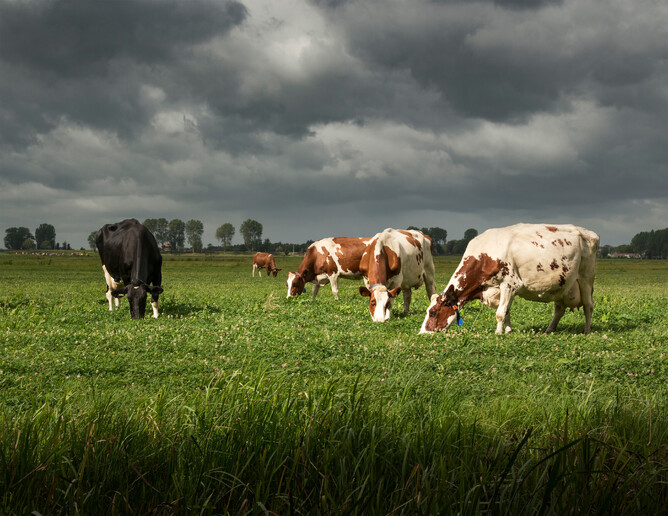Amongst the raft of negative effects of the recent extreme wet weather, there have been increased outbreaks of Salmonella on farms across Southland and South Otago. A real kick in the guts for farmers that are already having a tough time.
Salmonella in cattle is not usually common. In a typical season, we may only see one or two significant outbreaks and you might get the odd individual case. A farm might only have a case once in 20 years. Because of this, many stock are unvaccinated against the disease.
The disease
This spring we’ve seen an unusual surge of Salmonella on dairy farms. It strikes without warning and spreads rapidly. It’s a stress-related disease and the continued cold, rainy conditions have created more stress for stock, contributing to the increase.
This highly infectious disease is usually spread by a small number of carrier animals to the rest of their herd or flock, transferring through faeces. Symptoms include a sudden drop in milk production in cows, diarrhoea, high temperature and rapid loss of body condition. The disease can also cause pregnancies to be aborted.
Affected animals get a particular ‘look’ – I call it the racehorse look – with a tucked-up belly and a sadness in their eyes. Once you see it you will never forget it. They get very sick, very quickly and death is likely. A delay of just 48 hours in the diagnosis results in a hopeless case for survival. The initial sign of “off her milk” for dairy cows can easily be missed to untrained staff members.
Salmonella has a high mortality rate. In cattle it can have a death rate of 8-10% and up to half a herd can be affected and require treatment. Early identification is so important, as well as isolating suspected cases. Fast, aggressive treatment is necessary to save affected animals and stop an outbreak from escalating – cases can jump up exponentially when not picked up quickly.
Salmonella is also a health risk to farmers themselves. It can pass from animals to humans, so hygiene in sheds and around stock is very important. Wear gloves and use disinfectant. The disease can also be transferred through contaminated milk, so avoid drinking unpasteurised milk from the vat.
There are many strains of Salmonella bacteria. A faecal culture will confirm a diagnosis and identify which particular strain you are dealing with. Given how rapidly the disease spreads, you and your vet will have already begun treating animals before the results are in to try and minimise the outbreak.
Vaccination
Preventative vaccination is key to reducing the likelihood of a severe and expensive outbreak. The cost of the vaccine is a small amount compared to having the disease. Vet care, treatments, abortions, animal losses and, for dairy farmers, lost milk production can add up to the tens or even hundreds of thousands of dollars, and massively impact a farm.
In most cases, the cost of vaccinating every year would be repaid if an outbreak happened once every 15-20 years. For a large outbreak, where 15% or more of stock are affected, this would be repaid if an outbreak only occurred every 30-40 years.
For dairy herds, the recommended timing for giving the Salmonella vaccine, Salvexin+B, is mid-late lactation (before drying off) as there can be a drop in milk production for the first day or two after vaccination.
However, it can be administered to cows at any time throughout the season, particularly in the face of an outbreak to try and contain the spread of the disease.
Note, it can take 7-10 days to see a slowing down in case numbers after the first dose during an outbreak. It’s then recommended that animals vaccinated during an outbreak receive a booster shot.
Protecting sheep
Salvexin+B is also effective for sheep. There are two main types of Salmonella that are seen in sheep in New Zealand: Salmonella Brandenburg usually strikes in spring and can cause large numbers of abortions and ewe deaths, and Salmonella Hindmarsh often occurs in summer and autumn.
Vaccinating your flock against Salmonella soon will put them in a better position going into summer and will give them protection next spring.
Lambs and calves can also be vaccinated and it’s a good idea to vaccinate rams and bulls before mating.
Management practices
On top of vaccination, some farm management processes may help prevent a potentially devastating outbreak. These include:
Reducing stress in your animals as much as you can. Diseases often lie dormant in carriers until a stressful event occurs. This could be feed stress or weather stress, like we’ve seen this season.
Cleaning feed troughs regularly.
Being aware of where potentially contaminated faeces might spread on your farm and keeping vulnerable animals, such as calves and lambs, away from these areas. Salmonella can survive for a long time under the right environmental conditions (up to half a year, easily).
Having a good pest control programme around where feed and supplements are stored and fed out (as bacteria can spread from pests to stock).
Considering what you are feeding on-farm. For example, feeding high levels of magnesium oxide or feeding it in pelleted form can increase the pH of the rumen, which favours growth of bacteria.
The risk of a Salmonella outbreak is real and this season may change the way we look at vaccination for diseases like this. I’m sure those who have experienced it never want to deal with it ever again! As vets, we’ve certainly seen enough this year and know how devastating it can be.
Talk to your vet for more information about vaccinating your herd or flock. Dairy farmers, ask your KeyVet to give you a reminder before dry off.

